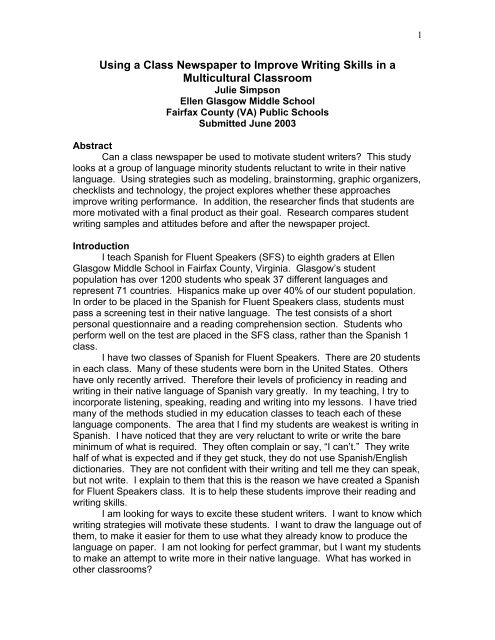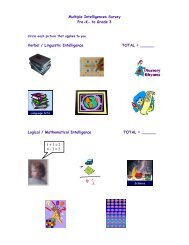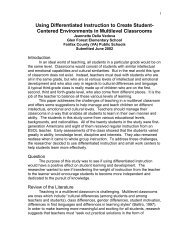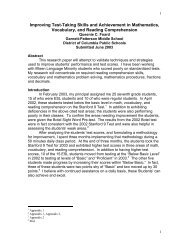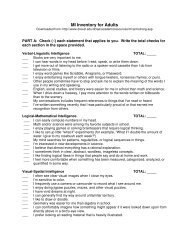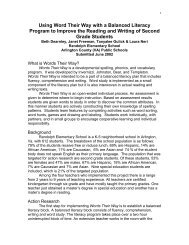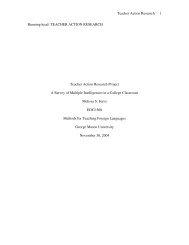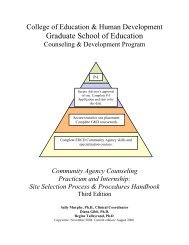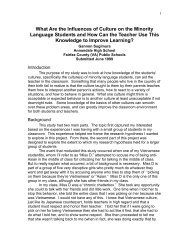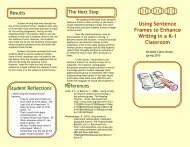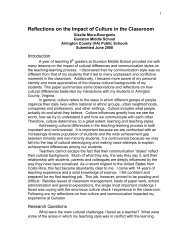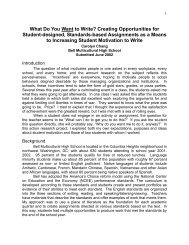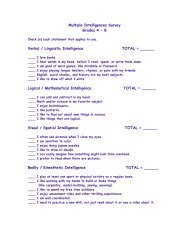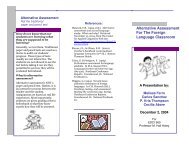Using a Class Newspaper to Improve Writing Skills in a ... - GSE
Using a Class Newspaper to Improve Writing Skills in a ... - GSE
Using a Class Newspaper to Improve Writing Skills in a ... - GSE
Create successful ePaper yourself
Turn your PDF publications into a flip-book with our unique Google optimized e-Paper software.
1<br />
<strong>Us<strong>in</strong>g</strong> a <strong>Class</strong> <strong>Newspaper</strong> <strong>to</strong> <strong>Improve</strong> <strong>Writ<strong>in</strong>g</strong> <strong>Skills</strong> <strong>in</strong> a<br />
Multicultural <strong>Class</strong>room<br />
Julie Simpson<br />
Ellen Glasgow Middle School<br />
Fairfax County (VA) Public Schools<br />
Submitted June 2003<br />
Abstract<br />
Can a class newspaper be used <strong>to</strong> motivate student writers This study<br />
looks at a group of language m<strong>in</strong>ority students reluctant <strong>to</strong> write <strong>in</strong> their native<br />
language. <strong>Us<strong>in</strong>g</strong> strategies such as model<strong>in</strong>g, bra<strong>in</strong>s<strong>to</strong>rm<strong>in</strong>g, graphic organizers,<br />
checklists and technology, the project explores whether these approaches<br />
improve writ<strong>in</strong>g performance. In addition, the researcher f<strong>in</strong>ds that students are<br />
more motivated with a f<strong>in</strong>al product as their goal. Research compares student<br />
writ<strong>in</strong>g samples and attitudes before and after the newspaper project.<br />
Introduction<br />
I teach Spanish for Fluent Speakers (SFS) <strong>to</strong> eighth graders at Ellen<br />
Glasgow Middle School <strong>in</strong> Fairfax County, Virg<strong>in</strong>ia. Glasgow’s student<br />
population has over 1200 students who speak 37 different languages and<br />
represent 71 countries. Hispanics make up over 40% of our student population.<br />
In order <strong>to</strong> be placed <strong>in</strong> the Spanish for Fluent Speakers class, students must<br />
pass a screen<strong>in</strong>g test <strong>in</strong> their native language. The test consists of a short<br />
personal questionnaire and a read<strong>in</strong>g comprehension section. Students who<br />
perform well on the test are placed <strong>in</strong> the SFS class, rather than the Spanish 1<br />
class.<br />
I have two classes of Spanish for Fluent Speakers. There are 20 students<br />
<strong>in</strong> each class. Many of these students were born <strong>in</strong> the United States. Others<br />
have only recently arrived. Therefore their levels of proficiency <strong>in</strong> read<strong>in</strong>g and<br />
writ<strong>in</strong>g <strong>in</strong> their native language of Spanish vary greatly. In my teach<strong>in</strong>g, I try <strong>to</strong><br />
<strong>in</strong>corporate listen<strong>in</strong>g, speak<strong>in</strong>g, read<strong>in</strong>g and writ<strong>in</strong>g <strong>in</strong><strong>to</strong> my lessons. I have tried<br />
many of the methods studied <strong>in</strong> my education classes <strong>to</strong> teach each of these<br />
language components. The area that I f<strong>in</strong>d my students are weakest is writ<strong>in</strong>g <strong>in</strong><br />
Spanish. I have noticed that they are very reluctant <strong>to</strong> write or write the bare<br />
m<strong>in</strong>imum of what is required. They often compla<strong>in</strong> or say, “I can’t.” They write<br />
half of what is expected and if they get stuck, they do not use Spanish/English<br />
dictionaries. They are not confident with their writ<strong>in</strong>g and tell me they can speak,<br />
but not write. I expla<strong>in</strong> <strong>to</strong> them that this is the reason we have created a Spanish<br />
for Fluent Speakers class. It is <strong>to</strong> help these students improve their read<strong>in</strong>g and<br />
writ<strong>in</strong>g skills.<br />
I am look<strong>in</strong>g for ways <strong>to</strong> excite these student writers. I want <strong>to</strong> know which<br />
writ<strong>in</strong>g strategies will motivate these students. I want <strong>to</strong> draw the language out of<br />
them, <strong>to</strong> make it easier for them <strong>to</strong> use what they already know <strong>to</strong> produce the<br />
language on paper. I am not look<strong>in</strong>g for perfect grammar, but I want my students<br />
<strong>to</strong> make an attempt <strong>to</strong> write more <strong>in</strong> their native language. What has worked <strong>in</strong><br />
other classrooms
2<br />
After tak<strong>in</strong>g a broad look at teach<strong>in</strong>g and learn<strong>in</strong>g <strong>in</strong> my classroom, I<br />
decided that some changes needed <strong>to</strong> be made <strong>in</strong> the <strong>in</strong>struction so that my<br />
students would be more motivated <strong>to</strong> write. The purpose of this study was <strong>to</strong><br />
identify what activities I could try <strong>in</strong> class <strong>to</strong> help prevent writer’s block. <strong>Us<strong>in</strong>g</strong><br />
data from this study, I hope <strong>to</strong> <strong>in</strong>corporate my f<strong>in</strong>d<strong>in</strong>gs <strong>in</strong><strong>to</strong> future lesson plans <strong>to</strong><br />
better motivate Spanish speakers <strong>to</strong> write <strong>in</strong> their native language.<br />
Literature Review<br />
Try<strong>in</strong>g <strong>to</strong> motivate student writers has been a challenge for many teachers<br />
<strong>in</strong> classrooms of all ages. Many students don’t take pride <strong>in</strong> their work or are<br />
satisfied with do<strong>in</strong>g just enough <strong>to</strong> get by. Accord<strong>in</strong>g <strong>to</strong> Shirley Hildebrand<br />
Benson (2000), teachers are spend<strong>in</strong>g <strong>to</strong>o much time and energy on lessons, but<br />
students are still do<strong>in</strong>g mediocre work. She believes that there is a need for<br />
change <strong>in</strong> education because of this lack of motivation. After observ<strong>in</strong>g <strong>in</strong> other<br />
classrooms, Benson found that students appeared <strong>to</strong> be highly motivated when<br />
teachers allowed them <strong>to</strong> self-manage their own work. When students were able<br />
<strong>to</strong> set goals for themselves, they could work at their own pace as long as the<br />
work got done and the quality was acceptable. Benson felt students responded<br />
positively <strong>to</strong> added responsibility and they like hav<strong>in</strong>g choices. Ultimately it<br />
<strong>in</strong>creased their self-esteem.<br />
Lynda A. Holmes also wrote an article about unmotivated students titled,<br />
What do students mean when they say, “I hate writ<strong>in</strong>g” (Holmes, 2001). The<br />
title caught my eye because I hear that same expression from many of my<br />
students when we work on writ<strong>in</strong>g assignments. In her article, she states that<br />
students can acquire the motivation and engagement necessary <strong>to</strong> learn <strong>to</strong> write<br />
well. Holmes feels educa<strong>to</strong>rs should take advantage of opportunities <strong>to</strong> help<br />
students overcome their problems with writ<strong>in</strong>g through the use of strategies and<br />
activities that promote motivation and engagement with writ<strong>in</strong>g. For example,<br />
students struggl<strong>in</strong>g with “writer’s block” can write notes <strong>in</strong> an outl<strong>in</strong>e format, ask<br />
other students what they have found helpful <strong>in</strong> overcom<strong>in</strong>g writer’s block, or work<br />
on a different task or activity for a while and get back <strong>to</strong> the writ<strong>in</strong>g assignment.<br />
She states that students are usually more motivated and engaged with writ<strong>in</strong>g<br />
assignments when they choose their writ<strong>in</strong>g genres. This will play an important<br />
role <strong>in</strong> my research because control is an important issue, particularly <strong>in</strong> middle<br />
school.<br />
Sheila Alber also tries <strong>to</strong> motivate student writers by us<strong>in</strong>g a classroom<br />
newspaper (Alber, 1999). Her approach <strong>to</strong> motivat<strong>in</strong>g reluctant writers is <strong>to</strong> allow<br />
them <strong>to</strong> work with their peers and provide them with opportunities <strong>to</strong> be<br />
published. She feels that students are reluctant <strong>to</strong> practice writ<strong>in</strong>g because it is<br />
difficult and complex. She found success with a classroom newspaper because<br />
it allowed students <strong>to</strong> direct their writ<strong>in</strong>g <strong>to</strong> a specific audience and <strong>in</strong>creased<br />
their motivation. Alber’s article focused on ma<strong>in</strong>stream<strong>in</strong>g because students at<br />
various levels can benefit from the variety of activities <strong>in</strong>volved <strong>in</strong> produc<strong>in</strong>g a<br />
classroom newspaper. At Glasgow Middle School, ma<strong>in</strong>stream<strong>in</strong>g is particularly<br />
important with our student population. In one classroom a teacher may have<br />
students with learn<strong>in</strong>g disabilities, students <strong>in</strong> the gifted and talented program
3<br />
and students learn<strong>in</strong>g English as a second language. Keep<strong>in</strong>g all students<br />
motivated <strong>to</strong> write is a challenge.<br />
Derek Furr <strong>in</strong> an advocate of the use of writ<strong>in</strong>g workshops <strong>in</strong> class <strong>to</strong><br />
motivate needy students <strong>to</strong> compose mean<strong>in</strong>gful essays (Furr, 2003). Like me,<br />
he has a group of students who do not know what <strong>to</strong> write because they are not<br />
sure how <strong>to</strong> start. Furr teaches his students the procedures needed <strong>to</strong> complete<br />
the writ<strong>in</strong>g process. He uses model<strong>in</strong>g and bra<strong>in</strong>s<strong>to</strong>rm<strong>in</strong>g strategies as well as<br />
activities <strong>in</strong> order <strong>to</strong> plan, draft, revise and edit a piece of writ<strong>in</strong>g. He found that<br />
by teach<strong>in</strong>g the nuts and bolts of writ<strong>in</strong>g <strong>in</strong> class workshops, students learn how<br />
<strong>to</strong> beg<strong>in</strong>, how <strong>to</strong> develop a piece of writ<strong>in</strong>g and are surprised by how much they<br />
can do.<br />
Motivat<strong>in</strong>g reluctant writers is the common theme <strong>to</strong> all of the studied<br />
research. I th<strong>in</strong>k that creat<strong>in</strong>g a student newspaper <strong>in</strong> Spanish would reflect a<br />
respect for the large number of Hispanic children at Glasgow and therefore<br />
motivate them <strong>to</strong> write about their culture. The research clearly shows that low<br />
motivation can be improved by us<strong>in</strong>g a variety of strategies, such as a class<br />
newspaper, writ<strong>in</strong>g workshop, and allow<strong>in</strong>g students <strong>to</strong> be active <strong>in</strong> the writ<strong>in</strong>g<br />
process. The research <strong>in</strong>dicates that these strategies make a positive impact on<br />
students’ self-confidence, which is what I hope <strong>to</strong> accomplish by my study.<br />
Methods<br />
This is my first year teach<strong>in</strong>g Spanish for Fluent Speakers. I was not<br />
given a set curriculum, but was <strong>to</strong>ld <strong>to</strong> help these students improve their read<strong>in</strong>g<br />
and writ<strong>in</strong>g skills <strong>in</strong> their native language of Spanish. As mentioned earlier, the<br />
students’ level of proficiency <strong>in</strong> read<strong>in</strong>g and writ<strong>in</strong>g <strong>in</strong> their native language vary<br />
greatly, but all the students need <strong>to</strong> improve their writ<strong>in</strong>g skills.<br />
I had made the assumption that s<strong>in</strong>ce my Spanish-speak<strong>in</strong>g students<br />
learned the writ<strong>in</strong>g process <strong>in</strong> English class, naturally they would be able <strong>to</strong><br />
transfer those skills <strong>to</strong> writ<strong>in</strong>g <strong>in</strong> Spanish. My assumption was <strong>in</strong>correct. My<br />
students were afraid of the blank page. They dreaded writ<strong>in</strong>g. And not only that,<br />
I found that they needed more practice with the writ<strong>in</strong>g process.<br />
Because my objective was <strong>to</strong> f<strong>in</strong>d out what strategies would motivate<br />
students <strong>to</strong> write <strong>in</strong> their native language, I began this project by survey<strong>in</strong>g my<br />
students. First I asked them what their goals and expectations were <strong>in</strong> my<br />
Spanish for Fluent Speakers class. Some responses received were:<br />
• To learn how <strong>to</strong> spell<br />
• To learn <strong>to</strong> write better<br />
• To know when <strong>to</strong> use accents<br />
• I don’t want <strong>to</strong> get mixed up with the present, past and future<br />
• To feel comfortable read<strong>in</strong>g and writ<strong>in</strong>g like the way I speak Spanish<br />
• I want <strong>to</strong> be able <strong>to</strong> speak and write <strong>in</strong> just Spanish because sometimes I<br />
say th<strong>in</strong>gs <strong>in</strong> English <strong>to</strong>o<br />
• My goal is <strong>to</strong> write better <strong>in</strong> Spanish because at home I only speak<br />
Spanish but I write better <strong>in</strong> English<br />
• I want <strong>to</strong> be able <strong>to</strong> write better <strong>in</strong> English and Spanish <strong>to</strong> get a good job<br />
and make a lot of money and so my family is proud of me
4<br />
Although students had many excellent goals for the year <strong>in</strong> Spanish,<br />
<strong>in</strong>clud<strong>in</strong>g the desire <strong>to</strong> learn <strong>to</strong> improve writ<strong>in</strong>g skills, I still found that they did not<br />
like <strong>to</strong> write. In order <strong>to</strong> f<strong>in</strong>d out exactly what it was that students did not like<br />
about writ<strong>in</strong>g, I surveyed the class. When asked why they do not like <strong>to</strong> write, the<br />
comments I got from the students varied:<br />
• I don’t know how <strong>to</strong> beg<strong>in</strong><br />
• I don’t know how <strong>to</strong> beg<strong>in</strong> a paragraph<br />
• I don’t know how <strong>to</strong> express myself<br />
• I don’t like accents<br />
• I don’t know how <strong>to</strong> give details<br />
• I don’t write well <strong>in</strong> Spanish<br />
• My hand hurts<br />
• It’s bor<strong>in</strong>g<br />
• I have <strong>to</strong> th<strong>in</strong>k a lot and sometimes I don’t know the word<br />
In the survey, I also asked students <strong>to</strong> tell me what they would prefer<br />
writ<strong>in</strong>g about if they were required <strong>to</strong> write <strong>in</strong> class. They <strong>to</strong>ld me that they like <strong>to</strong><br />
write journals and do projects. I was also <strong>to</strong>ld that they like <strong>to</strong> write e-mails,<br />
cards, and letters because they th<strong>in</strong>k it is more casual and they don’t have <strong>to</strong><br />
write the way teachers expect you <strong>to</strong> write <strong>in</strong> class (you don’t have <strong>to</strong> th<strong>in</strong>k so<br />
much). A few students also <strong>to</strong>ld me that they like <strong>to</strong> write about th<strong>in</strong>gs that they<br />
are <strong>in</strong>terested <strong>in</strong>, such as sports and music. With this <strong>in</strong> m<strong>in</strong>d, I realized that if I<br />
wanted <strong>to</strong> get my students excited about writ<strong>in</strong>g, I needed <strong>to</strong> have them choose<br />
<strong>to</strong>pics that <strong>in</strong>terest them.<br />
I got the idea of us<strong>in</strong>g a class newspaper <strong>to</strong> motivate students from an<br />
article I read by Sheila Alber (1999). It worked for reluctant writers <strong>in</strong> her<br />
classroom, so I decided that I would give it a try with my Spanish-speak<strong>in</strong>g<br />
students. But first I had <strong>to</strong> solve the blank page problem. I decided <strong>to</strong> start the<br />
writ<strong>in</strong>g process from scratch and try some different strategies <strong>in</strong> class <strong>to</strong> re<strong>in</strong>force<br />
good writ<strong>in</strong>g skills. We began by analyz<strong>in</strong>g good writ<strong>in</strong>g, then experimented with<br />
different bra<strong>in</strong>s<strong>to</strong>rm<strong>in</strong>g activities, learned how <strong>to</strong> write perfect paragraphs and<br />
f<strong>in</strong>ally, we tried different types of writ<strong>in</strong>g assignments <strong>in</strong> class, <strong>in</strong>clud<strong>in</strong>g writ<strong>in</strong>g<br />
an article for a class newspaper.<br />
First, we analyzed good writ<strong>in</strong>g. We do not have a textbook <strong>in</strong> this<br />
Spanish for Fluent Speakers class, but I do get supplemental read<strong>in</strong>g magaz<strong>in</strong>es<br />
<strong>in</strong> Spanish from Scholastic News. I also picked up some local newspapers <strong>in</strong><br />
Spanish. I modeled some good examples of writ<strong>in</strong>g <strong>in</strong> each. We <strong>to</strong>ok a closer<br />
look at one of the articles about Colombia. Together students helped me cluster<br />
the ideas <strong>in</strong> the article on<strong>to</strong> a word web graphic organizer on the overhead (see<br />
Appendix C). I wanted this bra<strong>in</strong>s<strong>to</strong>rm<strong>in</strong>g activity <strong>to</strong> allow students <strong>to</strong> exam<strong>in</strong>e<br />
what the writer may have mapped out before writ<strong>in</strong>g the article. We started with<br />
the ma<strong>in</strong> idea or <strong>to</strong>pic <strong>in</strong> the middle circle and students helped me write the<br />
support<strong>in</strong>g ideas and details from the article <strong>in</strong> the surround<strong>in</strong>g areas.<br />
Next, we bra<strong>in</strong>s<strong>to</strong>rmed <strong>in</strong>formation for a <strong>to</strong>pic of the students’ choice.<br />
They picked El Salvador, where the majority of my students are from. After
hav<strong>in</strong>g modeled the web about Colombia, students unders<strong>to</strong>od what was<br />
expected and were eager <strong>to</strong> offer support<strong>in</strong>g ideas and details for the web about<br />
El Salvador.<br />
The next part of the assignment was <strong>to</strong> write a paragraph us<strong>in</strong>g our new<br />
ideas and details about El Salvador. Even after gather<strong>in</strong>g <strong>in</strong>formation and<br />
organiz<strong>in</strong>g it <strong>in</strong> a web, some students still did not know how <strong>to</strong> beg<strong>in</strong> writ<strong>in</strong>g a<br />
paragraph. So I <strong>to</strong>ok time out of class <strong>to</strong> <strong>in</strong>troduce a m<strong>in</strong>i-lesson on writ<strong>in</strong>g<br />
perfect paragraphs. I gave students a labeled paragraph with the perfect<br />
<strong>in</strong>gredients: a <strong>to</strong>pic sentence, 2-3 support<strong>in</strong>g sentences with 2-3 details and one<br />
conclud<strong>in</strong>g sentence. We then practiced unscrambl<strong>in</strong>g sentences <strong>to</strong> put them <strong>in</strong><br />
the correct order for a perfect paragraph. And f<strong>in</strong>ally, we practiced writ<strong>in</strong>g a<br />
perfect paragraph of our own <strong>to</strong>gether as a class. After writ<strong>in</strong>g one or two<br />
sentences of our shared paragraph, students beg<strong>in</strong> <strong>to</strong> contribute orally and f<strong>in</strong>ish<br />
the rest themselves.<br />
As soon as students unders<strong>to</strong>od how <strong>to</strong> use this word web graphic<br />
organizer <strong>to</strong> help them beg<strong>in</strong> their writ<strong>in</strong>g, I began <strong>to</strong> share other types of webs<br />
for them <strong>to</strong> use when bra<strong>in</strong>s<strong>to</strong>rm<strong>in</strong>g (see Appendix A and D). I felt confident that<br />
they could use these strategies effectively <strong>to</strong> get their ideas on paper, thus<br />
elim<strong>in</strong>at<strong>in</strong>g the blank page. In addition, most students unders<strong>to</strong>od the mechanics<br />
of a well-written paragraph. Now it was time <strong>to</strong> expand this idea and ask them <strong>to</strong><br />
write five paragraph essays.<br />
Rather than assign all students the same <strong>to</strong>pic, I wanted <strong>to</strong> give them the<br />
opportunity <strong>to</strong> select their own ideas based on their <strong>in</strong>terests. My class<br />
newspaper idea seemed <strong>to</strong> work perfectly <strong>to</strong> fit both the feedback I received from<br />
the class surveys and I thought it would motivate students <strong>to</strong> write s<strong>in</strong>ce they<br />
could pick their own <strong>to</strong>pics. Many students decided <strong>to</strong> write about their own<br />
country of orig<strong>in</strong>, much like the article we had seen modeled, but others wrote<br />
about world soccer leagues, what they like about school, sports, after school<br />
activities, fashion and music, heroes and pets.<br />
In addition <strong>to</strong> choos<strong>in</strong>g their own <strong>to</strong>pic, I thought the idea of gett<strong>in</strong>g<br />
published would also get students excited <strong>to</strong> write. The first step <strong>in</strong> the process<br />
was <strong>to</strong> get their ideas out <strong>in</strong> the open through bra<strong>in</strong>s<strong>to</strong>rm<strong>in</strong>g and then <strong>to</strong> cluster<br />
the words <strong>in</strong><strong>to</strong> mean<strong>in</strong>gful associations. With each grouped association, they<br />
were encouraged <strong>to</strong> write a perfect paragraph. <strong>Us<strong>in</strong>g</strong> our model paragraph, they<br />
beg<strong>in</strong> <strong>to</strong> write their own newspaper articles. Most of the class seemed <strong>to</strong> be<br />
catch<strong>in</strong>g on and they worked very well <strong>in</strong>dependently. For those who cont<strong>in</strong>ued<br />
<strong>to</strong> struggle with generat<strong>in</strong>g text, there was much support available, the class web<br />
and model paragraphs.<br />
In addition, I circulated around the room, conduct<strong>in</strong>g one on one<br />
conferences, a critical component for keep<strong>in</strong>g students on task. It was also a<br />
good way <strong>to</strong> suggest revisions and give them feedback quickly. Because our<br />
objective was <strong>to</strong> create a classroom newspaper, students seemed <strong>to</strong> be more<br />
motivated know<strong>in</strong>g that their writ<strong>in</strong>g would be published. They asked <strong>to</strong> get<br />
detailed <strong>in</strong>formation off the Internet, revise and complete their articles on the<br />
computer. I observed the students engaged <strong>in</strong> this activity – work<strong>in</strong>g<br />
5
6<br />
<strong>in</strong>dependently <strong>to</strong> complete required checklists. With a deadl<strong>in</strong>e, I saw more<br />
writ<strong>in</strong>g than I had seen all year.<br />
F<strong>in</strong>d<strong>in</strong>gs<br />
The data collected was primarily qualitative. My observations, answers <strong>to</strong><br />
the surveys given <strong>to</strong> students, and a comparison of written work at the beg<strong>in</strong>n<strong>in</strong>g<br />
and end of the year were used as the basis for my f<strong>in</strong>d<strong>in</strong>gs.<br />
After students f<strong>in</strong>ished their newspaper articles, I compared their f<strong>in</strong>al<br />
product <strong>to</strong> work samples from the beg<strong>in</strong>n<strong>in</strong>g of the year, which I have saved <strong>in</strong><br />
student portfolios. The quality of work was much improved. Students are now<br />
writ<strong>in</strong>g <strong>in</strong>troductions with catchy attention grabbers, giv<strong>in</strong>g descriptive details and<br />
conclud<strong>in</strong>g with a clear summary of the ma<strong>in</strong> idea.<br />
In addition <strong>to</strong> compar<strong>in</strong>g work samples, I also wanted <strong>to</strong> f<strong>in</strong>d out if student<br />
attitudes had changed <strong>to</strong>wards writ<strong>in</strong>g. I gave them an end survey questionnaire<br />
<strong>to</strong> f<strong>in</strong>d out their op<strong>in</strong>ions on writ<strong>in</strong>g articles for a class newspaper. Students were<br />
asked if they enjoyed writ<strong>in</strong>g an article for the class newspaper, why or why not<br />
The responses were varied:<br />
• Yes, because I got <strong>to</strong> do research on the Internet<br />
• Yes, because it is easier <strong>to</strong> write when I get <strong>to</strong> pick my own <strong>to</strong>pic<br />
• Yes, because we didn’t have <strong>to</strong> write about anyth<strong>in</strong>g bor<strong>in</strong>g<br />
• Yes, because it was fun <strong>to</strong> use the computers <strong>in</strong> class<br />
• No, because I don’t like <strong>to</strong> write<br />
• No, because it was hard for me <strong>to</strong> th<strong>in</strong>k of a <strong>to</strong>pic<br />
When asked what they would do differently next time, students replied:<br />
• I want <strong>to</strong> write more about sports<br />
• I want <strong>to</strong> pr<strong>in</strong>t out a copy of the newspaper <strong>to</strong> show my friends and family<br />
• I want it <strong>to</strong> be more like a real newspaper<br />
• I want <strong>to</strong> have more computers available <strong>in</strong> class<br />
I have learned that although many of my students do not like <strong>to</strong> write, they<br />
do much better when they have structured assignments with clear expectations.<br />
By assign<strong>in</strong>g a newspaper article <strong>to</strong> each student <strong>in</strong> class, I found that they were<br />
more motivated <strong>to</strong> complete the assignment. In addition, the quality of their<br />
writ<strong>in</strong>g was much improved from work samples collected at the beg<strong>in</strong>n<strong>in</strong>g of the<br />
year. This could be due <strong>to</strong> a variety of reasons.<br />
First, students may have improved because they have seen many<br />
examples of good writ<strong>in</strong>g through the model<strong>in</strong>g activities done <strong>in</strong> class.<br />
Additional lessons were given dur<strong>in</strong>g the study <strong>in</strong> order <strong>to</strong> review paragraph<br />
writ<strong>in</strong>g. This enabled students <strong>to</strong> practice the essential components of good<br />
writ<strong>in</strong>g. Earlier <strong>in</strong> the year, I saw many poorly written paragraphs; now students<br />
have shown me that they can write a perfect paragraph, with a <strong>to</strong>pic sentence,<br />
support<strong>in</strong>g sentences and a clear conclusion.<br />
Students also practiced bra<strong>in</strong>s<strong>to</strong>rm<strong>in</strong>g with graphic organizers. The use of<br />
this strategy <strong>in</strong> class gave students many excellent ideas on how <strong>to</strong> elim<strong>in</strong>ate the<br />
blank page fear and <strong>in</strong>stead, get their ideas down on paper. Students tried us<strong>in</strong>g
7<br />
a number of graphic organizers <strong>in</strong> class and have demonstrated the ability <strong>to</strong><br />
plan their writ<strong>in</strong>g. Some stick <strong>to</strong> preferred graphic organizers, others are will<strong>in</strong>g<br />
<strong>to</strong> try new ideas.<br />
Another strategy students practiced dur<strong>in</strong>g the project, was <strong>to</strong> use a<br />
checklist. Students stayed on task when they knew the teacher’s expectations.<br />
They had a checklist for the components of a good paragraph (see Appendix B)<br />
as well as a checklist for what was expected <strong>to</strong> be <strong>in</strong>cluded <strong>in</strong> their newspaper<br />
article. This improved the content of their writ<strong>in</strong>g because they were sure not <strong>to</strong><br />
leave anyth<strong>in</strong>g out.<br />
References<br />
Alber, Sheila R. (1999). “I Don’t Like <strong>to</strong> Write, But I Love <strong>to</strong> Get Published”:<br />
<strong>Us<strong>in</strong>g</strong> a <strong>Class</strong>room <strong>Newspaper</strong> <strong>to</strong> Motivate Reluctant Writers. Read<strong>in</strong>g &<br />
<strong>Writ<strong>in</strong>g</strong> Quarterly, 15, 335-360.<br />
Furr, Derek (2003). Struggl<strong>in</strong>g readers get hooked on writ<strong>in</strong>g. The Read<strong>in</strong>g<br />
Teacher 56(6), 518-525.<br />
Hildebrand Benson, Shirley (2000). Make M<strong>in</strong>e an A. Educational Leadership,<br />
57(5). 30-32.<br />
Holmes, Lynda A. (2001). What do Students Mean When They Say, “I Hate<br />
<strong>Writ<strong>in</strong>g</strong>” Teach<strong>in</strong>g <strong>in</strong> the Two-Year College: 172-178.<br />
Hough<strong>to</strong>n Miffl<strong>in</strong> English. Cluster/Word Web 1,<br />
http://www.eduplace.com/graphicorganizer/pdf/cluster.pdf<br />
The Perfect Paragraph. Scholastic S<strong>to</strong>ryworks. January 2003 10(4), 22-23.<br />
Vacca, Richard T. & Vacca, JoAnne L. (1999). Content Area Read<strong>in</strong>g: Literacy<br />
and Learn<strong>in</strong>g Across the Curriculum. Bos<strong>to</strong>n: Allyn & Bacon.
Appendix A<br />
8
9<br />
Appendix B<br />
Perfect Paragraph Checklist:<br />
1 <strong>to</strong>pic sentence <br />
2-3 support<strong>in</strong>g sentences <br />
2-3 detail sentences <br />
1 conclud<strong>in</strong>g sentence <br />
The use of technology certa<strong>in</strong>ly motivated students <strong>to</strong> f<strong>in</strong>ish the draft and<br />
f<strong>in</strong>al copies of their article <strong>in</strong> order <strong>to</strong> type it on the computer. Technology was an<br />
important piece <strong>in</strong> motivat<strong>in</strong>g these students <strong>to</strong> write. Many were creative with<br />
the presentation of their writ<strong>in</strong>g (see Appendix E-G). In addition, hav<strong>in</strong>g a f<strong>in</strong>al<br />
product <strong>in</strong> m<strong>in</strong>d got students excited and more motivated <strong>to</strong> write. The idea of<br />
publish<strong>in</strong>g the newspaper gave them a goal. Many students volunteered <strong>to</strong><br />
format the class document because they enjoy us<strong>in</strong>g the computers <strong>in</strong> class.<br />
It is evident from my observations that each of the above fac<strong>to</strong>rs<br />
contributed <strong>to</strong> the improved quality of students’ writ<strong>in</strong>g as well as their motivation<br />
<strong>to</strong> write for this project. In my experiences, I have found that students become<br />
frustrated with writ<strong>in</strong>g when they feel like they are left on their own without any<br />
guidance from the teacher. I want my students <strong>to</strong> become <strong>in</strong>dependent writers,<br />
by choos<strong>in</strong>g their own <strong>to</strong>pic, genre and bra<strong>in</strong>s<strong>to</strong>rm<strong>in</strong>g style. But I found that<br />
giv<strong>in</strong>g them <strong>in</strong>dependence before they were ready <strong>to</strong> write on their own was<br />
frustrat<strong>in</strong>g for them and led <strong>to</strong> writer’s block. I have learned that by model<strong>in</strong>g and<br />
practic<strong>in</strong>g good writ<strong>in</strong>g skills <strong>in</strong> class, students learn <strong>to</strong> build a foundation of<br />
plann<strong>in</strong>g, draft<strong>in</strong>g and revis<strong>in</strong>g <strong>in</strong> order <strong>to</strong> publish. It’s a good start <strong>to</strong> future<br />
writ<strong>in</strong>g <strong>in</strong> any language.<br />
Implications for Further Study<br />
Based on what I have learned from this study, I will cont<strong>in</strong>ue <strong>to</strong> use the<br />
newspaper project <strong>in</strong> my Spanish for Fluent Speakers classes <strong>to</strong> motivate<br />
student writers. I would even encourage other teachers <strong>to</strong> use it <strong>in</strong> their<br />
curriculum, English or Spanish. However, there are a few questions I still have<br />
follow<strong>in</strong>g my research study which make me th<strong>in</strong>k that I would try new th<strong>in</strong>gs next<br />
time. For example, I wonder if I could stretch this newspaper project <strong>in</strong><strong>to</strong> a year<br />
long assignment I also want <strong>to</strong> know why some of my students still say that<br />
they don’t like <strong>to</strong> write. Have I given them enough choice and variety <strong>in</strong> their<br />
writ<strong>in</strong>g assignments And how else can I improve the technology component for<br />
this newspaper project<br />
My students did perform better with the deadl<strong>in</strong>es and structure that the<br />
newspaper provided. Therefore, I would consider do<strong>in</strong>g this aga<strong>in</strong> <strong>in</strong> class. I<br />
would like <strong>to</strong> create a class newspaper aga<strong>in</strong>, but next time we could publish the<br />
f<strong>in</strong>al paper a few times throughout the year. Maybe we could have deadl<strong>in</strong>es<br />
once per quarter, rather than just a one-time assignment.<br />
Although students did perform very well on their writ<strong>in</strong>g assignments for<br />
the newspaper, some students’ attitudes <strong>to</strong>wards writ<strong>in</strong>g didn’t <strong>in</strong>crease as much<br />
as I had hoped. I am curious about how students would do if I let them have
more ownership of the newspaper. Maybe they could create their own deadl<strong>in</strong>es,<br />
<strong>to</strong>pics for articles, format and layout of the paper. Perhaps they could take<br />
<strong>in</strong>creas<strong>in</strong>g ownership over the course of a year. If we cont<strong>in</strong>ued the newspaper<br />
project and added different deadl<strong>in</strong>es with different <strong>to</strong>pics, I may be able <strong>to</strong> reach<br />
more students and tap <strong>in</strong><strong>to</strong> their <strong>in</strong>terests. I want them <strong>to</strong> be excited and proud<br />
about their writ<strong>in</strong>g. What k<strong>in</strong>ds of authentic material could I have them write<br />
Some ideas that come <strong>to</strong> m<strong>in</strong>d are news, style, enterta<strong>in</strong>ment, advice, astrology,<br />
comics and advertisements. Maybe students could help bra<strong>in</strong>s<strong>to</strong>rm their own<br />
columns or themes.<br />
F<strong>in</strong>ally, technology seemed <strong>to</strong> be my biggest challenge with the class<br />
newspaper project. I had envisioned myself comb<strong>in</strong><strong>in</strong>g each of the students’<br />
articles <strong>in</strong><strong>to</strong> one big class newspaper, but <strong>in</strong> the end, we just pr<strong>in</strong>ted each of the<br />
articles <strong>in</strong>dividually. I don’t know very much about popular publish<strong>in</strong>g programs<br />
except how <strong>to</strong> create columns <strong>in</strong> Microsoft Word. In the future, I would try <strong>to</strong><br />
familiarize myself with a program that might work easily for our class project. I<br />
could try work<strong>in</strong>g with the school’s technology resource teacher for more tra<strong>in</strong><strong>in</strong>g<br />
and support. In addition, the media lab could be used dur<strong>in</strong>g this unit so that all<br />
students would have the opportunity <strong>to</strong> use the computer <strong>to</strong> write, edit and format<br />
his or her article.<br />
This study has taught me that us<strong>in</strong>g a class newspaper can improve<br />
writ<strong>in</strong>g skills <strong>in</strong> a multicultural classroom. I will cont<strong>in</strong>ue <strong>to</strong> use the newspaper<br />
project <strong>in</strong> my Spanish for Fluent Speakers classes <strong>to</strong> motivate student writers.<br />
This project does leave room for improvement, and there are many th<strong>in</strong>gs I would<br />
like <strong>to</strong> change. However, I saw a positive change <strong>in</strong> student performance and<br />
<strong>in</strong>creased motivation with this project.<br />
10


